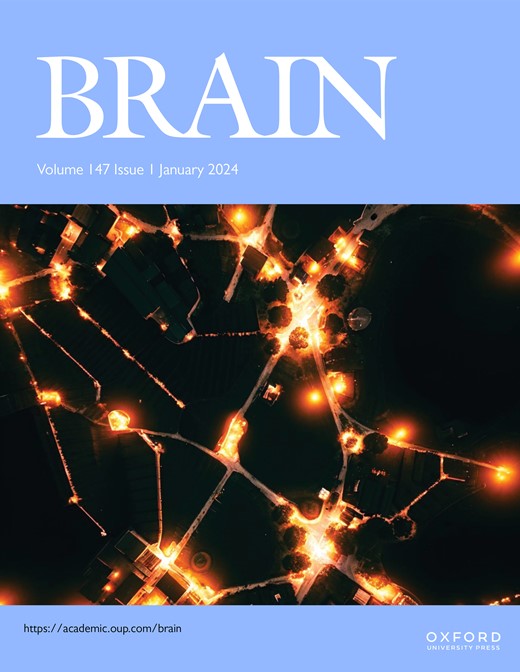Novel risk loci in LGI1-antibody encephalitis: genome-wide association study discovery and validation cohorts
IF 10.6
1区 医学
Q1 CLINICAL NEUROLOGY
引用次数: 0
Abstract
Encephalitis with antibodies to leucine-rich glioma-inactivated 1 (LGI1-Ab-E) is a common form of autoimmune encephalitis, presenting with seizures and neuropsychiatric changes, predominantly in older males. More than 90% of patients carry the human leucocyte antigen (HLA) class II allele, HLA-DRB1*07:01. However, this is also present in 25% of healthy controls. Therefore, we hypothesised the presence of additional genetic predispositions. In this genome-wide association study and meta-analysis, we studied a discovery cohort of 131 French LGI1-Ab-E and a validation cohort of 126 American, British and Irish LGI1-Ab-E patients, ancestry-matched to 2613 and 2538 European controls, respectively. Outside the known major HLA signal, we found two single nucleotide polymorphisms (SNPs) at genome-wide significance (p < 5 x 10−8), implicating PTPRD, a protein tyrosine phosphatase, and LINC00670, a non-protein coding RNA gene. Meta-analysis defined four additional non-HLA loci, including the protein coding COBL gene. Polygenic risk scores with and without HLA variants proposed a contribution of non-HLA loci. In silico network analyses suggested LGI1 and PTPRD mediated interactions via the established receptors of LGI1, ADAM22 and ADAM23. Our results identify new genetic loci in LGI1-Ab-E. These findings present opportunities for mechanistic studies and offer potential markers of susceptibility, prognostics and therapeutic responses.LGI1-抗体脑炎的新风险位点:发现和验证队列的全基因组关联研究
富亮氨酸胶质瘤灭活1抗体脑炎(LGI1-Ab-E)是一种常见的自身免疫性脑炎,表现为癫痫发作和神经精神改变,主要发生于老年男性。90% 以上的患者携带人类白细胞抗原 (HLA) II 类等位基因 HLA-DRB1*07:01。然而,在 25% 的健康对照组中也存在这种情况。因此,我们假设还存在其他遗传倾向。在这项全基因组关联研究和荟萃分析中,我们研究了由 131 名法国 LGI1-Ab-E 患者组成的发现队列,以及由 126 名美国、英国和爱尔兰 LGI1-Ab-E 患者组成的验证队列,这些患者的祖先分别与 2613 名和 2538 名欧洲对照者相匹配。在已知的主要 HLA 信号之外,我们还发现了两个具有全基因组意义(p < 5 x 10-8)的单核苷酸多态性(SNPs),分别与蛋白酪氨酸磷酸酶 PTPRD 和非蛋白编码 RNA 基因 LINC00670 有关。元分析确定了另外四个非 HLA 基因位点,包括蛋白编码 COBL 基因。有 HLA 变异和无 HLA 变异的多基因风险评分表明,非 HLA 基因位点也有作用。硅网络分析表明,LGI1 和 PTPRD 通过 LGI1、ADAM22 和 ADAM23 的受体介导相互作用。我们的研究结果确定了 LGI1-Ab-E 的新遗传位点。这些发现为机理研究提供了机会,并为易感性、预后和治疗反应提供了潜在标记。
本文章由计算机程序翻译,如有差异,请以英文原文为准。
求助全文
约1分钟内获得全文
求助全文
来源期刊

Brain
医学-临床神经学
CiteScore
20.30
自引率
4.10%
发文量
458
审稿时长
3-6 weeks
期刊介绍:
Brain, a journal focused on clinical neurology and translational neuroscience, has been publishing landmark papers since 1878. The journal aims to expand its scope by including studies that shed light on disease mechanisms and conducting innovative clinical trials for brain disorders. With a wide range of topics covered, the Editorial Board represents the international readership and diverse coverage of the journal. Accepted articles are promptly posted online, typically within a few weeks of acceptance. As of 2022, Brain holds an impressive impact factor of 14.5, according to the Journal Citation Reports.
 求助内容:
求助内容: 应助结果提醒方式:
应助结果提醒方式:


